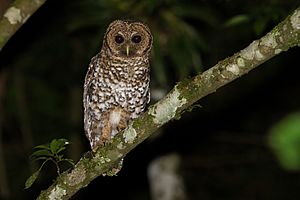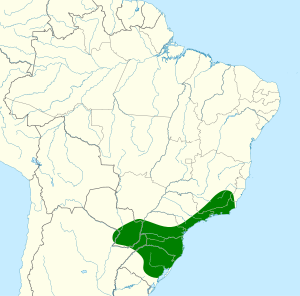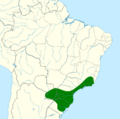Rusty-barred owl facts for kids
Quick facts for kids Rusty-barred owl |
|
|---|---|
 |
|
| Conservation status | |
| Scientific classification | |
| Genus: |
Strix
|
| Species: |
hylophila
|
 |
|
The rusty-barred owl (Strix hylophila) is a medium-sized owl. It is often called a "typical owl." You can find this owl in Argentina, Brazil, and Paraguay. In Brazil, it is known as the Brazilian owl.
Contents
About the Rusty-Barred Owl Family
The rusty-barred owl belongs to a group of owls called Strix. There are seven kinds of Strix owls living in South America. Scientists think the rusty-barred owl is most like the Chaco owl and the rufous-legged owl. These three owls make very different sounds compared to other Strix owls. Because of this, scientists are studying if they should be in their own special group. The rusty-barred owl is the only type of its kind, meaning it does not have different subspecies.
What Does the Rusty-Barred Owl Look Like?
The rusty-barred owl is about 35 centimeters (14 inches) long. Male owls weigh about 250 to 340 grams (9 to 12 ounces). Female owls are a bit heavier, weighing about 275 to 395 grams (10 to 14 ounces).
This owl has light, rusty-brown circles around its eyes, called facial discs. These circles have darker brown rings inside them. It also has small white "eyebrows." The top part of its body has stripes of white, brown, and orange-buff colors. Its chest and sides are orangish-buff, and its belly is whiter. Both these areas have dark brown stripes. The owl's legs are covered in feathers. It has dark brown eyes, a yellowish-horn colored beak, and yellowish-gray toes. Young owls are mostly buff-colored with faint darker stripes.
Where Do Rusty-Barred Owls Live?
The rusty-barred owl lives in southeastern Brazil, from the state of Minas Gerais down to Rio Grande do Sul. It also lives in southeastern Paraguay and in the very northeastern part of Misiones Province in Argentina.
These owls live in different kinds of wooded areas. They can be found inside and at the edges of:
- Forests on mountains (montane forests)
- Forests that stay green all year (tropical evergreen forests)
- Forests in cooler areas (temperate forests)
- Forests that have grown back after being cut down (secondary forests)
- Pine tree farms
They can even live close to where people live. You can find them from sea level up to at least 1,000 meters (3,300 feet) high.
Owl Behavior
Movement
Scientists believe that the rusty-barred owl stays in the same area all year long. It does not usually migrate or move to different places.
Feeding Habits
The rusty-barred owl hunts at night. It is a nocturnal hunter. While we don't know everything about what it eats, we do know it catches small mammals and birds. It also eats arthropods, which are creatures like insects and spiders. It probably eats reptiles and amphibians too. One study in Brazil found that most of its food was rodents, and the rest was mostly small marsupials. Sometimes, it hunts for food high up in the trees.
Reproduction and Life Cycle
The rusty-barred owl's breeding season seems to be from August to October. However, some reports say it can also be from December to March. These owls make their nests inside holes in trees. The female owl lays two or three eggs. She sits on the eggs to keep them warm for 28 to 29 days until they hatch. The male owl brings food to the female and the baby owls. He also helps keep the baby owls warm. The young owls leave the nest when they are 32 to 35 days old. They become fully independent about three months after that.
Vocalization
The rusty-barred owl's song sounds like a deep, frog-like grunt: "grugruu-grugruugrugru." Both male and female owls sing, and sometimes they sing together. They also make "rrrrroh" sounds and long, drawn-out calls that sound like "i-ew-eh."
Conservation Status
The IUCN (International Union for Conservation of Nature) says the rusty-barred owl is of "Least Concern." This means it is not currently in danger of disappearing. However, this owl lives in a somewhat small area. Its population is believed to be shrinking. This is mainly because its home (habitat) is being lost due to fires and logging. The good news is that it does live in a few protected areas, which helps keep it safe.
See also
 In Spanish: Cárabo Brasileño para niños
In Spanish: Cárabo Brasileño para niños
Images for kids



